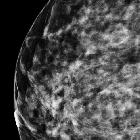comedo type ductal carcinoma in situ

A comedo-type ductal carcinoma in situ, also known as comedocarcinoma in situ is the high grade subtype of ductal carcinoma in situ (DCIS). It completely fills and dilates the ducts and lobules in TDLU with plugs of high grade tumor cells with central necrosis "comedonecrosis".
It is the most aggressive of intraductal carcinomas. In 30% of cases it can be multicentric and / or multifocal.
Casting-type microcalcifications are the most frequent mammographic finding (78% of cases) in comedotype DCIS.
Histologically DCIS-comedo is diagnosed when at least one duct in the breast is filled and expanded by large, markedly atypical cells.
It has the risk of occult infiltration. A comedo that extends for more than 2.5 cm has the combination of invasive component in 45% of cases.
Infiltrating ductal carcinoma (infiltrative ductal carcinoma with central necrosis) may so closely mimic the pattern of DCIS with central comedonecrosis that on initial morphological analysis these foci of tumors are often labeled as DCIS (high grade, comedo type).
Siehe auch:
und weiter:

 Assoziationen und Differentialdiagnosen zu Komedokarzinom:
Assoziationen und Differentialdiagnosen zu Komedokarzinom:
